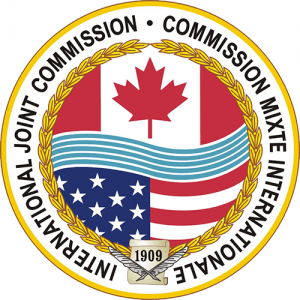
But 2017 brought “A massive loss of expertise and passion”
Several major organizations that help protect the Great Lakes saw long-time leaders leave their posts in 2017. New experts and lawmakers will take the reins in 2018 to help protect the five lakes in the coming years, and, by all accounts, they have a tough job ahead of them.
International Joint Commission (IJC) Chairman Lana Pollack, whose own future is uncertain under the new Trump administration, is not taking any of these changes in Great Lakes leadership lightly. The IJC is an international organization originally created by the Boundary Waters Treaty, signed by Canada and the U.S. in 1909. In addition to resolving disputes between the two countries, the Commission rules upon projects affecting boundary and transboundary waters.
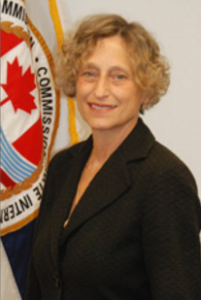
Lana Pollack U.S Section Chair of the International Joint Commission, courtesy of ijc.org
Pollack tells Great Lakes Now , “The departures of Cam Davis at EPA, Dave Ullrich at the Cities Initiative and Tim Eder from the Great Lakes Commission, represent a massive loss of expertise and passion. These men had remarkable knowledge of the three corners of Great Lakes protection: that is the complex ecology of the lakes, the policies essential to restore and protect them, and the people in positions of power who can make or break the lakes’ health.”
Great Lakes Now talked with some of the familiar names in the Great Lakes community about how and why they left, and talked with some of the people who are taking their places.
The Great Lakes Commission is a binational, interstate compact agency established in 1955 to advance the economic and environmental health of the Great Lakes – St. Lawrence River Region. Executive Director Tim Eder left in August to join the Charles Stewart Mott Foundation. Eder tells Great Lakes Now, “It was an honor to lead the organization for the last 11 years and it will be exciting to see a new leader move the organization to new heights in 2018.”
Eder says, “The Mott Foundation has been quietly helping make the organizations dedicated to protecting the Great Lakes stronger and more effective for over two decades. It’s a thrill to be supporting the work of these grantees and helping confront the challenges we face in the coming years.”
Eder’s official title is Program Officer in the Environment Program. He will manage a grant making portfolio that focusses on addressing freshwater challenges, particularly those in the Great Lakes Basin. The Great Lakes Commission’s Deputy Director Tom Crane will serve as interim executive director until the commission hires Eder’s replacement.
Chairman of the Board of the Great Lakes Commission: It’s a routine position change, but it comes at a pivotal time for the Great Lakes. Jon Allan, Director of the Office of the Great Lakes at the
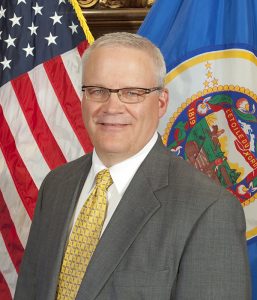
Commissioner John Linc Stine, courtesy of Minnesota.gov
Michigan Department of Environmental Quality, was replaced by John Linc Stine. Stine, who is Commissioner of the Minnesota Pollution Control Agency tells Great Lakes Now, “ The departures of Great lakes leaders occurring because of retirements or job transitions will be challenging in some ways – hundreds of years of professional experience and institutional knowledge is never possible to replace. But organizational transitions are inevitable and change can bring positive new ideas to Great Lakes leadership. I am excited to work with people across the region who will work to promote and protect the incredible resource values of the Great Lakes. Some important challenges ahead include promoting the water and navigational infrastructure needs of the Great Lakes, promoting sustainable economic growth of the Great lakes region and maintaining vigilant protection of the Great Lakes from aquatic invasive species.”
Dave Ullrich served as Executive Director of the Great Lakes and St. Lawrence Cities Initiative for 14 years. The organization is a binational coalition of 131 U.S. and Canadian mayors and local officials working to advance the protection and restoration of the Great Lakes and St. Lawrence River. Ullrich stepped down in March 2017. He tells Great Lakes Now, “Local governments in Canada and the U.S. have established themselves as a positive presence for action and results to protect and restore one of the world’s largest freshwater resources over the past 14 years through the work of over 130 cities representing more than 17 million people in the Great Lakes and St. Lawrence Cities Initiative. The future challenge presented by climate change and all of its ramifications and a lack of commitment and leadership by national leaders to deal with it is our largest challenge, but the continued threats from invasive species, nutrient runoff, combined sewer overflows, loss of habitat, and more will need our undivided attention in the years to come.”
Ullrich is now an advisor to the organization. Ullrich was replaced by the former Mayor of Racine Wisconsin, John Dickert. Ullrich says, “John Dickert, the new CEO and President of the Cities Initiative, brings a wealth of local government experience from his time as Mayor of Racine, along with experience in Madison and Washington, and is well positioned to take the Cities Initiative to new levels in their work on the Great Lakes and St. Lawrence.”
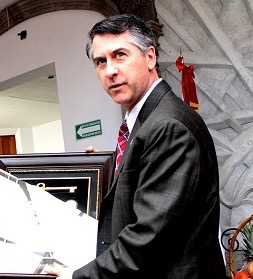
John Dickert, President and CEO of the Great Lakes and St. Lawrence Cities Initiative
Dickert tells Great Lakes Now , “My move really was more of a transformation. I went to city hall 8 years ago to take a city struggling with a high unemployment rate (17%) and crime rate (#1 per capita), a housing crisis and budget in crisis, with the goal of fixing it and providing a bright future for the city. When I left, unemployment was at 4%, crime was at a 65-year low, and more housing was rebuilt than in history, along with a balanced budget with strong reserves.”
Dickert says, “The Great Lakes are now facing a similar challenge with invasive issues and an administration that is not as passionate as the last, which could spell disaster for this precious resource. So, I was given the opportunity to move up to now do my best to help resolve the issues the mayors are facing. I hope I can help fix these problems with the most talented and dedicated people in the world, the mayors!”

U.S. Environmental Protection Agency, courtesy of epa.gov
Cameron Davis has often been called the “Czar of the Great Lakes.” His official title until recently was Federal Interdepartmental Great Lakes Restoration Coordinator. Davis coordinated the work of 11 federal departments and served as the Obama administration’s liaison to Congress on Great Lakes issues starting in 2009.
Davis tells Great Lakes Now, “One thing that the Bush and Obama administrations both supported was strong interagency coordination. It reduces duplication of effort, leverages departments’ authorities, and saves taxpayers money. All to help protect public drinking water, cut toxic pollution and keep invasive species out, like Asian carp. While campaigning in September 2008, Obama (the candidate) pledged to create a position to help with this coordination. The Trump administration hasn’t filled the position. But for the immediate future, we’ll have to keep working to keep the Great Lakes Restoration Initiative budget and EPA’s agency-wide budget. For the Great Lakes to be restored and protected, it’s not enough to have just a Great Lakes budget. The EPA institutionally has to be restored and protected.”
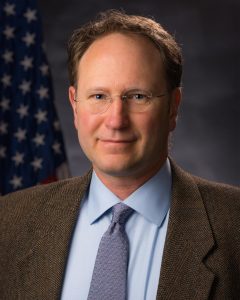
Cameron Davis Former Senior Advisor to the U.S. EPA Administrator, courtesy of EPA
Davis says, “My current position is vice president at GEI Consultants. I’m focused, for example, on green infrastructure. There’s a dearth of private engineering expertise on sustainable infrastructure across the country and especially our region. And public-private partnerships for green infrastructure design-build. It reduces storm water, saves ratepayer dollars and provides communities with more open space.”
Yet another recent departure: John Hartig, who is credited with creating North America’s only International Wildlife refuge in the Detroit River, retired from the position he held with the U.S. Fish and Wildlife Service for 17 years. He says, “I feel blessed and honored to have convened the Conservation Vision workshop in 2000, given testimony on the Hill in support of establishing the refuge, become the first Refuge Manager, fostered partnerships for conservation, and been part of a team that has seen the refuge grow from 300 acres to over 18,700 acres today, and has seen the refuge become a leader in bringing conservation to cities in innovative ways.”
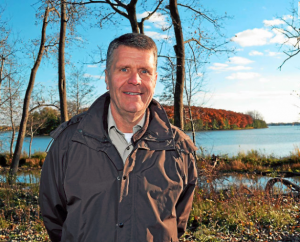
John Hartig, Refuge Manager of the Detroit River International Wildlife Refuge, courtesy of fws.gov
However, Hartig is not disappearing from the Great Lakes landscape. He has been appointed a Fulbright Scholar in Canada to work between Canada and the U.S. on restoration of the Great Lakes. After his 6 month Fulbright, he says, “I will be working with the International Association for Great Lakes Research and the Aquatic Ecosystem Health and Management Society to continue my interdisciplinary research.” Hartig will also be contributing stories and essays to greatlakesnow.org on a regular basis.
Tim Eder. Cameron Davis. Dave Ullrich. John Hartig. That’s a lot of losses of Great Lakes Leaders in just one year.
But The International Joint Commission’s Lana Pollack says she’s confident about who will fill their shoes. She says, “Fortunately, when we’re looking for Great Lakes expertise and leadership potential, there is a strong bench in the public, private and non-profit sectors across the eight Great Lakes States. And although we see pressure to diminish the essential environmental protections coming out of the current administration, bipartisan support for protecting these waters is very strong in Congress. IJC’s recent Triennial Assessment of Progress report (TAP), reveals good progress under those leaders who’ve now moved on. However, that report also reveals the fragility of the Great Lakes. It calls for better ways to track and prevent harm to human health, greater efforts to keep hazardous pollutants out of the lakes, and laws that go beyond the voluntary programs that have failed to reduce the terrible algal blooms primarily caused by bad farming practices. Without bold and well informed leadership equal to those who’ve retired, the Great Lakes will surely slide backward.”
1 Comment
-
Former Mayor of Racine John Dickert’s city will provide 7mgd of Lake Michigan water to a new Foxconn plant in a neighboring city within the basin but miles outside the city itself. It was reported last week that the Foxconn plant will use more water than the City of Waukesha per day and only return 70% to Lake Michigan.
One concern Waukesha’s lawyers had discussed privately was that eventually the Compact Council members will realize that once a thousand straws are stuck into the Great Lakes, by exportation from bottles, manufacturers, and everyday consumers consumptive use, the Great Lakes will be drawn down and the rules will change.
That is why Waukesha wants Lake Michigan water now despite their primary source of water having risen rapidly to it’s highest level since 1973 because of significantly reduced pumping throughout the region and other communities switching to Great Lakes water.
They successfully got the application approved because they didn’t share all they knew and the DNR deceptively presented critical information about the 2014 Radium levels in the drinking water.


